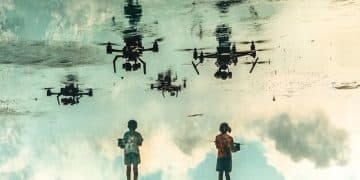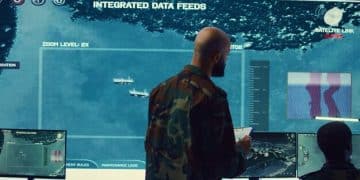US Military’s New Focus: Countering Drone Warfare Tactics

The US military is intensifying efforts to develop and deploy advanced measures to counter drone warfare tactics, crucial for safeguarding personnel and assets against evolving threats in modern conflict zones.
The landscape of modern warfare is undergoing a profound transformation, driven largely by the proliferation of unmanned aerial systems (UAS). This shift has cemented the US Military’s New Focus: Countering Drone Warfare Tactics as a critical dimension of national defense strategy.
The Ubiquity of Drones in Modern Conflict
Drones, once a niche capability, have become omnipresent on battlefields worldwide. From reconnaissance to precision strikes, their versatility presents both opportunities and significant challenges for military forces.
The low cost and relative ease of operation of many drone systems mean that state and non-state actors alike can deploy them, complicating traditional air defense strategies. This democratization of aerial power forces militaries to adapt rapidly.
The Evolving Threat Landscape
The evolution of drone technology is relentless, moving beyond simple surveillance tools to sophisticated platforms capable of swarming, autonomous operations, and even carrying various payloads, including explosives. This technological leap demands an equally sophisticated response.
- Swarm Attacks: Coordinated, numerous drones overwhelming defenses.
- Enhanced Autonomy: Drones operating with minimal human input, increasing speed and unpredictability.
- Payload Diversification: Carrying more potent and varied destructive or disruptive payloads.
- Stealth and Size Reduction: Smaller, harder-to-detect drones capable of infiltrating contested airspace.
The psychological impact of continuous drone surveillance or attack also cannot be underestimated, affecting troop morale and operational tempo. Understanding these multifaceted threats is the first step in effective counter-drone strategy.
The US military recognizes that addressing this threat isn’t merely about developing new systems but also about integrating them into a comprehensive defensive posture. This includes everything from early warning systems to active interception. The experiences from recent conflicts have underscored the urgent need for robust, layered defenses against these aerial adversaries.
In essence, the age of drone warfare necessitates a paradigm shift in how military forces approach air superiority and ground protection. The emphasis moves from merely controlling the skies against traditional aircraft to deterring or neutralizing thousands of small, fast, and often elusive aerial threats. This foundational understanding drives much of the US military’s current investment and research efforts.
Technological Frontiers in Counter-Drone Systems
Responding to the diverse and rapidly evolving drone threat requires a broad spectrum of technological solutions. The US military is investing heavily in various counter-UAS (C-UAS) technologies, from traditional kinetic approaches to cutting-edge non-kinetic methods.
These technologies are designed to detect, identify, track, and ultimately neutralize hostile drones, often in complex operational environments where civilian drone traffic might also be present.
Kinetic vs. Non-Kinetic Solutions
Both kinetic and non-kinetic approaches have distinct advantages and limitations, dictating their suitability for different scenarios. Kinetic systems involve physically destroying the drone, while non-kinetic aim to disrupt or disable them.
Kinetic Countermeasures: These are often traditional methods adapted for smaller targets. Examples include:
- Missiles and Interceptors: Smaller, more agile versions of traditional air defense missiles designed to hit fast-moving drones.
- Autocannons and Machine Guns: Automated gun systems capable of tracking and engaging multiple drone targets simultaneously.
- Net Guns: Projectiles that deploy a net to entangle and bring down drones without causing collateral damage.
Non-Kinetic Countermeasures: These methods focus on disrupting the drone’s functionality rather than destroying it. They are often preferred in urban areas due to reduced collateral risk.
- Electronic Warfare (EW) Jammers: Disrupting the drone’s command and control signals or GPS navigation.
- Cyber Attacks: Exploiting vulnerabilities in the drone’s software or communication protocols to take control or neutralize it.
- Directed Energy Weapons (DEWs): High-power microwaves or laser systems that can melt or disable drone electronics from a distance at the speed of light.
The integration of these diverse technologies is key to developing a layered defense system. A single solution is unlikely to be effective against all types of drones or attack scenarios. Therefore, the strategic emphasis is on combining various capabilities to create a robust and adaptable counter-drone umbrella.

Research and development continue at an accelerated pace, with the goal of making these systems more compact, energy-efficient, and capable of operating autonomously. The future of counter-drone technology likely involves increased automation and artificial intelligence to manage the complexity of defending against large swarms.
The US military is also exploring counter-drone systems that can differentiate between friendly and hostile drones, a crucial capability to prevent fratricide in complex airspace operations. This identification technology is paramount for effective deployment in congested areas.
Ultimately, the technological arms race against drone warfare is continuous, demanding constant innovation and adaptation. The investment in diverse C-UAS solutions reflects the urgency and complexity of this modern military challenge.
Adapting Doctrine and Training for Drone Warfare
Beyond technological solutions, the US military understands that countering drone warfare effectively requires significant doctrinal shifts and adapted training methodologies. It’s not enough to have the best equipment; personnel must know how to use it optimally within a rapidly changing operational environment.
This adaptation encompasses everything from battlefield awareness and threat assessment to rules of engagement and force protection protocols designed specifically for the low-altitude, pervasive drone threat.
Integrating C-UAS into All Force Levels
Historically, air defense was primarily the domain of specialized units. However, the prevalence of drones means that every soldier, sailor, airman, and marine could potentially face a drone threat. This necessitates integrating counter-UAS capabilities and training across all echelons.
- Individual Soldier Training: Basic awareness of drone threats, identifying suspicious activity, and knowledge of immediate defensive actions.
- Small Unit Tactics: Developing procedures for detecting, reporting, and responding to drone incursions at the squad or platoon level.
- Large Scale Exercises: Incorporating robust drone scenarios into major military exercises to test C-UAS systems and tactics at brigade, division, and corps levels.
- Cross-Branch Collaboration: Ensuring seamless communication and coordination between different military branches regarding drone detection and neutralization efforts.
The aim is to create a “sensor-to-shooter” chain that can operate quickly and efficiently, closing the kill chain on hostile drones before they can inflict damage. This often involves rapid data sharing and decision-making enabled by advanced command and control systems.
Training scenarios are becoming increasingly realistic, simulating drone swarms and sophisticated evasion tactics. This allows military personnel to practice engaging multiple targets simultaneously and making split-second decisions under pressure.
Furthermore, the legal and ethical implications of widespread drone use and counter-drone measures are continuously being reviewed. Rules of engagement must be clear, especially concerning actions in congested civilian areas, minimizing collateral damage, and ensuring proportionality.
The US military’s doctrinal shift represents a recognition that drone warfare is not a temporary phenomenon but a fundamental aspect of future conflicts. Therefore, continuous adaptation in training and doctrine is as vital as technological advancements in maintaining a decisive edge.
Intelligence, Surveillance, and Reconnaissance (ISR) in the Drone Era
The core of effective counter-drone warfare begins with superior Intelligence, Surveillance, and Reconnaissance (ISR). Understanding the adversary’s drone capabilities, intentions, and deployment patterns is paramount for preemptive and defensive actions.
ISR in the drone era is no longer just about detecting large aircraft; it’s about identifying small, fast-moving, and often commercially available platforms that can be weaponized with ease.
Advanced Detection and Tracking
Traditional radar systems, designed for larger aircraft, often struggle to detect small UAS. This has driven the development of new detection technologies specifically tailored for micro-drones and swarms.
- Specialized Radars: Millimeter-wave radars and other short-range systems optimized for small target detection.
- Acoustic Sensors: Microphones arrays that detect the unique sound signatures of different drone types.
- Electro-Optical/Infrared (EO/IR) Cameras: High-resolution cameras and thermal imagers that can visually track drones day and night.
- RF (Radio Frequency) Detection: Identifying drones by analyzing their communication signals, giving away their presence and control location.
The fusion of data from these diverse sensor types creates a more comprehensive picture of the airspace. Artificial intelligence and machine learning play a crucial role in analyzing vast amounts of sensor data, differentiating between legitimate and threatening drones, and predicting their trajectories.
This sophisticated data analysis enables quicker and more precise responses. It moves beyond simple detection to active identification of drone types, potential payloads, and even the likely origin of the operator by analyzing signal patterns.

Furthermore, SIGINT (Signals Intelligence) and GEOINT (Geospatial Intelligence) are vital in understanding and predicting drone threats. By monitoring drone control frequencies and analyzing operational patterns, intelligence agencies can often anticipate and disrupt attacks before they materialize.
The focus on robust ISR capabilities demonstrates the US military’s proactive approach to drone warfare. It’s about being one step ahead of the threat, understanding its evolution, and having the necessary tools to see and categorize every potential aerial adversary.
Effective ISR is the bedrock upon which all other counter-drone measures are built, providing the necessary situational awareness to deploy kinetic and non-kinetic responses efficiently and safely.
Developing Legal and Ethical Frameworks
As drone warfare evolves, so too must the legal and ethical frameworks governing its use and counter-measures. The proliferation of drones, especially commercially available ones, blurs the lines between civilian and military applications, posing complex challenges.
The US military is actively engaged in developing clear policies and procedures to ensure that C-UAS operations comply with national laws, international humanitarian law, and ethical considerations, particularly regarding proportionality and minimizing civilian harm.
Rules of Engagement and Collateral Damage
Establishing precise rules of engagement (ROE) for counter-drone operations is critical. Unlike traditional aerial threats that conform to established air traffic control and military protocols, drones can operate unpredictably and often in close proximity to civilian infrastructure or personnel.
Key considerations include:
- Identification of Hostile Intent: Clearly defining what constitutes a hostile drone and how its intent is determined, especially for unidentifiable or commercially available models.
- Proportionality of Force: Ensuring that the response to a drone threat is proportionate to the potential harm it poses, especially when kinetic solutions might cause unintended collateral damage.
- Location of Engagement: Developing policies for engaging drones in different environments (e.g., open combat zones vs. urban areas, near critical infrastructure).
- Post-Engagement Analysis: Implementing procedures for assessing the effectiveness of counter-measures and any unintended consequences.
The challenge is particularly acute with drone swarms or autonomous systems, where quick decisions are often necessary with limited human oversight. Ethical guidelines regarding the use of AI in decision-making processes for targeting are also under intense scrutiny.
Furthermore, addressing the legal status of airspace in regions where commercial drones are prevalent but potentially weaponized by non-state actors adds another layer of complexity. International cooperation in developing global norms for drone use and counter-use is becoming increasingly important.
The US military’s commitment to operating within a robust legal and ethical framework is vital for maintaining legitimacy and public trust, both domestically and internationally. This proactive approach ensures that advanced capabilities are used responsibly and adhere to the highest standards of conduct.
International Cooperation and Information Sharing
Countering drone warfare is not a challenge that any single nation can effectively tackle in isolation. The global nature of drone technology development and proliferation necessitates robust international cooperation and information sharing among allies.
The US military actively engages with partner nations to share intelligence, best practices, and collaborate on the development of new counter-UAS technologies and operational doctrines.
Allied Efforts and Joint Development
Collaboration with allies amplifies capabilities and accelerates learning. By pooling resources and expertise, nations can overcome limitations and create more comprehensive defensive strategies.
- Joint Exercises: Conducting multinational exercises to test integrated C-UAS systems and refine interoperability among allied forces.
- Technology Exchange Programs: Sharing research findings and collaborating on the development of next-generation counter-drone solutions.
- Intelligence Fusion Centers: Establishing platforms for real-time intelligence sharing on drone threats and adversary tactics.
- Standardization Initiatives: Working towards common standards for C-UAS equipment and procedures to enhance seamless integration during coalition operations.
The collective experience from various conflict zones, where allies might encounter different manifestations of the drone threat, provides invaluable insights for refining counter-strategies. This shared knowledge base is critical for staying ahead of rapidly evolving tactics.
Furthermore, collaborating on the legal and ethical aspects of drone warfare helps establish a shared understanding and common principles among like-minded nations, reinforcing international norms of responsible military conduct.
The emphasis on international cooperation underscores the understanding that the drone threat is a global challenge. A concerted, unified effort is the most effective way to mitigate risks and ensure collective security in an increasingly drone-populated battlespace.
| Key Area | Brief Description |
|---|---|
| 🛡️ Layered Defense | Combining kinetic and non-kinetic systems for comprehensive drone threat neutralization. |
| 🎓 Doctrine & Training | Adapting military strategy and training across all units to counter evolving drone tactics. |
| 📡 Advanced ISR | Enhancing intelligence, surveillance, and reconnaissance to detect and track small UAS. |
| 🤝 Global Collaboration | International partnerships to share intelligence and develop joint C-UAS capabilities. |
Frequently Asked Questions About Countering Drone Warfare
▼
The primary goal is to protect personnel, critical infrastructure, and assets from hostile drone threats, ensuring operational freedom and maintaining military superiority in complex battlespaces. This involves integrating advanced technologies and training to neutralize both individual drones and large swarms effectively.
▼
Technologies primarily fall into kinetic and non-kinetic categories. Kinetic solutions include missiles and net guns, while non-kinetic ones involve electronic warfare jammers, cyber attacks, and directed energy weapons like lasers. These are often combined into layered defense systems.
▼
Drones are a challenge due to their low cost, widespread availability, versatility, and ability to conduct mass attacks (swarms). Their small size and varied payloads make them difficult to detect and counter with traditional air defense systems, requiring innovative and adaptable responses.
▼
Training is adapting by integrating C-UAS awareness and tactics across all force levels, from individual soldiers to large units. Realistic exercises simulate drone swarm attacks, forcing rapid decision-making and efficient use of new technologies and protocols to ensure readiness.
▼
International cooperation is crucial for sharing intelligence, best practices, and joint development of C-UAS technologies. Allies work together to conduct joint exercises and standardize equipment, creating a stronger collective defense against a global and evolving drone threat.
Conclusion: A Continuous Evolution in Defense
The US military’s sharpened focus on countering drone warfare tactics reflects a profound and necessary adaptation to the evolving nature of modern conflict. From sophisticated technological countermeasures to significant shifts in doctrine, training, and international cooperation, the strategy is comprehensive. The ubiquity and adaptability of unmanned systems demand an agile and continuous evolution in defensive capabilities. This commitment ensures that the US military remains equipped to protect its forces and interests in an increasingly complex and drone-laden battlespace, emphasizing innovation, vigilance, and collaboration as cornerstones of future security.





